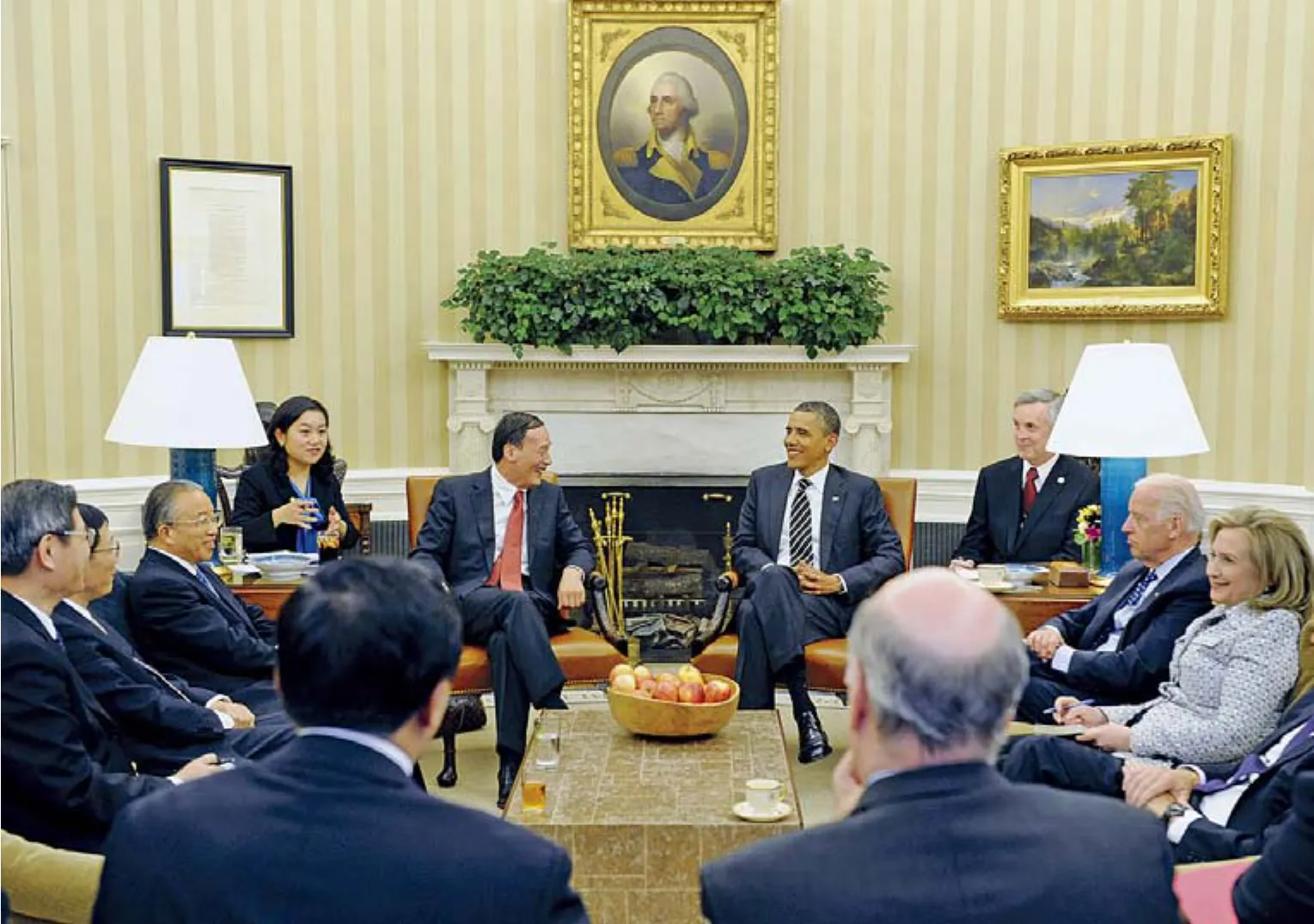Building the Sino-U.S. Bridge
2011-10-14ByWANGHONGGANG
By WANG HONGGANG
Building the Sino-U.S. Bridge
By WANG HONGGANG
Mutual confidence is key to a cooperative relationship between China and the United States
Held after a year of tension between China and the United States,and following a meeting between the presidents of both nations in January,the third round of the Sino-U.S. Strategic and Economic Dialogue(S&ED) had everyone’s attention. The world watched wide-eyed to see if the meeting,convened in Washington, D.C. on May 9-10,could usher in a new wave of healthy and stable development in Sino-U.S. relations.
A fragile relationship
Compared to tense relations in 2010,Sino-U.S. ties seem to be in calmer waters.This is no doubt thanks to the January summit between Chinese President Hu Jintao and U.S. President Barack Obama. Hu’s visit was regarded as the “most important high-level visit in Sino-U.S. relations” since Chinese leader Deng Xiaoping’s trip to the United States in 1979 shortly after the two countries established diplomatic ties.
The summit effectively reversed the downward spiral in bilateral relations and enhanced the two countries’ mutual understanding and trust. A Joint Statement issued after of fi cial talks stated that China and the United States would build a “cooperative partnership based on mutual respect and mutual benefit.” The statement addressed problems caused by the previous vague de finition of the nature of Sino-U.S. relations, and became a guideline for their future ties.
Also, unrest in the Middle East distracted U.S. attention from China, which helped lessen tensions in bilateral relations in recent months. On January 14, Tunisian President Zine El Abidine Ben Ali was ousted after ruling the country for more than two decades.Quickly, Tunisia’s domestic riots triggered a sweeping wave of disturbances across the Middle East.

Chaos in the Middle East had barely stopped when a massive earthquake and tsunami hit Japan on March 11, a U.S. ally in the Asia-Paci fi c region. This left Japan incapable of addressing contentious issues, particularly those involving China.
Against this backdrop, disputes between China and the United States were temporarily played down or covered up. This peace, however, is fragile. Chronic disputes over U.S.leaders’ meetings with the Dalai Lama, U.S.arms sales to Taiwan, the Korean Peninsula nuclear issue, as well as the United States’interference in territorial disputes in the East China Sea and the South China Sea will continue to hinder bilateral relations.
Since unrest broke out in the Middle East,the Obama administration has put increased momentum behind promoting democracy around the globe. It ratcheted up pressure on China by criticizing its human rights record,sparking strong reactions from Beijing.
Moreover, China’s first aircraft carrier is about to set sail. The United States and its allies are worried that could tilt the balance of power in the Asia-Paci fi c region. The United States is also concerned the development of the BRICS club, consisting of Brazil, Russia,India, China and South Africa, may in some way harm its interests. U.S. Secretary of State Hillary Clinton said the United States was in competition for global in fl uence with China at a Senate hearing in March. These have all added to the complexity of Sino-U.S. relations.
Sincere talks
Against this backdrop, the third round of the S&ED sought to narrow differences, enhance mutual trust and expand cooperation,with the aim of helping to build a long-term partnership between China and the United States.
This round of the S&ED displayed several highlights. To begin with, it created a favorable atmosphere for the two countries to re-forge an economic balance and address their disputes.
During the dialogue, both countries expressed their interests clearly. The United States asked China to accelerate the appreciation of the renminbi, open up financial markets, treat U.S. companies on an equal footing and strengthen intellectual property protection. China, in turn, asked the United States to pursue a responsible fiscal policy,relax hi-tech export controls against China,recognize China’s market economy status,treat Chinese investors fairly and refrain from politicizing economic issues.

BUILDING TRUST: U.S. President Barack Obama meets Chinese Vice Premier Wang Qishan and State Councilor Dai Bingguo in Washington, D.C. on May 9
Generally, the two countries managed to strike a balance, as evidenced in the Sino-U.S. Comprehensive Framework for Promoting Strong, Sustainable and Balanced Growth and Economic Cooperation, a milestone document signed at the S&ED. If this positive trend continues, it will greatly contribute to sustainable economic development for both countries and an economic rebalancing between them.
Another highlight was the establishment of the Sino-U.S. Strategic Security Dialogue(SSD). The military relationship has always been a weak area of Sino-U.S. relations. The SSD aims to make up for this by providing a forum for the two countries to address security issues, such as nuclear safety and maritime security.
With the inauguration of the SSD, a security track was added to the S&ED, which was originally a dialogue with two tracks—a strategic track and an economic track. Now,the S&ED involves three teams—an economic team, a diplomatic team and a security team—from each country.
During the first SSD, the two sides reached a number of agreements, including the launch of bilateral consultations on Asia-Paci fi c issues as well as a visit by Chen Bingde, Chief of the General Staff of the People’s Liberation Army, to the United States on May 15-22.
Both countries have great expectations on the future role of the SSD. Given the importance of the Asia-Paci fi c region and due to the two countries’ all-round engagement with other countries in this region, they need to give proper consideration to a series of issues, including balancing interests,developing mutually inclusive cooperative mechanisms, managing conflicts and sharing prosperity. This will be essential for China and the United States to realize peaceful coexistence in the Asia-Pacific region.
In addition, the United States aspires to play a dominant role in the new frontier of sea, airspace, outer space and cyberspace governance. Therefore, on the one hand,it needs support from emerging countries like China; on the other hand, it finds it necessary to regulate these countries’ actions. Given China’s growing concern over security issues, it also needs to strengthen coordination and cooperation with the United States.
Notably, the S&ED produced positive progress in strengthening strategic mutual trust. The S&ED process provides an opportunity for China and the United States to discuss strategic and long-term topics. It helps them to eliminate suspicions and build strategic mutual trust through dialogue and cooperation.
At this year’s S&ED, the two countries decided to expand cooperation and narrow differences while sticking to their own values and principles. During the dialogue, the U.S.side further showed respect for the Chinese way of thinking. Clinton described the development of Sino-U.S. relations with a Chinese saying—“like a person crossing a river by feeling his way over the stones.” She called on the two sides to effectively manage their complicated bilateral relations and not to let slippery stones derail progress. U.S. Treasury Secretary Timothy Geithner also quoted the Chinese saying, “share fortunes together,meet challenges together,” to call for further cooperation between the two major players in the global economy.
Of course, the two sides’ disagreements on issues such as human rights remained at the S&ED. But the fact that they could discuss these differences and make sure such differences did not interfere with the progress of other issues was a step forward.
The United States wants China to
● accelerate the appreciation of the renminbi
● open up financial markets
● treat U.S. companies fairly
● strengthen intellectual property protection
China wants the United States to
● pursue a responsible fiscal policy
● relax hi-tech export controls against China
● recognize China’s market economy status
● treat Chinese investors fairly
● refrain from politicizing economic issues

MILESTONE FRAMEWORK: Chinese Vice Premier Wang Qishan (second right, front) and U.S. Treasury Secretary Timothy Geithner sign a framework agreement on economic cooperation during the third round of the Sino-U.S. Strategic and Economic Dialogue in Washington, D.C. on May 10
Prospects
For China and the United States, whether they can establish a relationship of common prosperity depends on whether they can build strategic mutual trust. The recent series of actions by the two countries were all conducted based on this goal.
For instance, the second round of the Sino-U.S. Consultation on People-to-People Exchange held in Washington, D.C. in April was aimed at this. The S&ED was aimed at this. The coming visits of U.S. Vice President Joe Biden to China and Chinese Vice President Xi Jinping to the United States will also aim to accomplish this task.
Frequent exchanges in a wide range of fields can contribute to a true cooperative partnership. However, this will not be easy.What China and the United States will create is a new type of partnership in the 21st century featuring long-term peace and cooperation between two countries with different political systems, ideologies, and stages of development. There is neither experience to learn from nor examples to follow. This is destined to be a complex and dif fi cult process.
